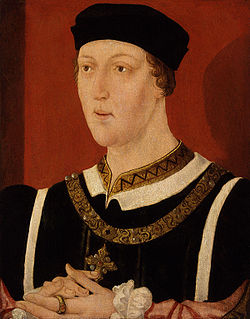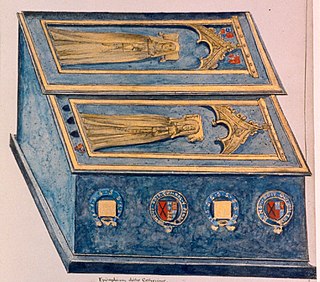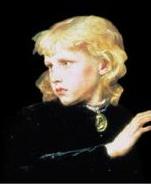Related Research Articles

Edward V was King of England and Lord of Ireland from 9 April to 26 June 1483. He succeeded his father, Edward IV, upon the latter's death. Edward V was never crowned, and his brief reign was dominated by the influence of his uncle and Lord Protector, the Duke of Gloucester, who deposed him to reign as King Richard III; this was confirmed by the Act entitled Titulus Regius, which denounced any further claims through his father's heirs.

Edward IV was King of England from 4 March 1461 to 3 October 1470, then again from 11 April 1471 until his death in 1483. He was a central figure in the Wars of the Roses, a series of civil wars in England fought between the Yorkist and Lancastrian factions between 1455 and 1487.

Henry VI was King of England from 1422 to 1461 and again from 1470 to 1471, and disputed King of France from 1422 to 1453. The only child of Henry V, he succeeded to the English throne at the age of nine months upon his father's death, and succeeded to the French throne on the death of his maternal grandfather, Charles VI, shortly afterwards.

Henry IV or Henry Bolingbroke was King of England from 1399 to 1413. He asserted the claim of his grandfather King Edward III, a maternal grandson of Philip IV of France, to the Kingdom of France. Henry was the first English ruler since the Norman Conquest, over three hundred years prior, whose mother tongue was English rather than French.

Elizabeth Woodville was Queen of England from her marriage to King Edward IV on 1 May 1464 until Edward was deposed on 3 October 1470, and again from Edward's resumption of the throne on 11 April 1471 until his death on 9 April 1483.

Elizabeth of York was Queen of England from her marriage to King Henry VII on 18 January 1486 until her death in 1503. Elizabeth married Henry after his victory at the Battle of Bosworth Field, which marked the end of the Wars of the Roses. Together, they had seven children.

George Plantagenet, Duke of Clarence, was the 6th son of Richard Plantagenet, 3rd Duke of York, and Cecily Neville, and the brother of English kings Edward IV and Richard III. He played an important role in the dynastic struggle between rival factions of the Plantagenets now known as the Wars of the Roses.

Anne Neville was an English queen, the younger of the two daughters and co-heiresses of Richard Neville, 16th Earl of Warwick. She became Princess of Wales as the wife of Edward of Westminster and then Queen of England as the wife of King Richard III.

Katherine Swynford, Duchess of Lancaster, also spelled Katharine or Catherine, was the third wife of John of Gaunt, Duke of Lancaster, a son of King Edward III. She had been the Duke's lover for many years before their marriage. The couple's children, born before the marriage, were later legitimised during the reign of the Duke's nephew, Richard II. When the Duke's son from his first marriage overthrew Richard, becoming Henry IV, he introduced a provision that neither they nor their descendants could ever claim the throne of England; however, the legitimacy for all rights was a parliamentary statute that Henry IV lacked the authority to amend.

The Princes in the Tower refers to the apparent murder in England in the 1480s of the deposed King Edward V of England and Richard of Shrewsbury, Duke of York. These two brothers were the only sons of King Edward IV and Elizabeth Woodville surviving at the time of their father's death in 1483. When they were 12 and 9 years old, respectively, they were lodged in the Tower of London by their paternal uncle and all-powerful regent the Duke of Gloucester. This was supposedly in preparation for Edward V's forthcoming coronation. However, before the young king could be crowned, he and his brother were declared illegitimate. Gloucester ascended the throne as Richard III.
Lady Eleanor Talbot, also known by her married name Eleanor Butler, was an English noblewoman. She was a daughter of John Talbot, 1st Earl of Shrewsbury. After the death of Edward IV of England in 1483 it was claimed by his brother Richard, the future Richard III, that she had had a legal precontract of marriage to Edward, which invalidated the king's later marriage to Elizabeth Woodville. According to Richard, this meant that he, rather than Edward's sons, was the true heir to the throne. Richard took the crown and imprisoned Edward's sons, who subsequently disappeared.

Titulus Regius is a statute of the Parliament of England, issued in 1484, by which the title of King of England was given to Richard III.

The House of York was a cadet branch of the English royal House of Plantagenet. Three of its members became kings of England in the late 15th century. The House of York descended in the male line from Edmund of Langley, 1st Duke of York, the fourth surviving son of Edward III. In time, it also represented Edward III's senior line, when an heir of York married the heiress-descendant of Lionel, Duke of Clarence, Edward III's second surviving son. It is based on these descents that they claimed the English crown. Compared with its rival, the House of Lancaster, it had a superior claim to the throne of England according to cognatic primogeniture, but an inferior claim according to agnatic primogeniture. The reign of this dynasty ended with the death of Richard III of England at the Battle of Bosworth Field in 1485. It became extinct in the male line with the death of Edward Plantagenet, 17th Earl of Warwick, in 1499.

Cecily Neville was an English noblewoman, the wife of Richard, Duke of York (1411–1460), and the mother of two kings of England—Edward IV and Richard III. Cecily Neville was known as "the Rose of Raby", because she was born at Raby Castle in Durham, and "Proud Cis", because of her pride and a temper that went with it, although she was also known for her piety. She herself signed her name "Cecylle".

Richard III is a play by William Shakespeare. It was probably written c. 1592–1594. It is labelled a history in the First Folio, and is usually considered one, but it is sometimes called a tragedy, as in the quarto edition. Richard III concludes Shakespeare's first tetralogy and depicts the Machiavellian rise to power and subsequent short reign of King Richard III of England.

Richard of Shrewsbury, Duke of York, was the sixth child and second son of King Edward IV of England and Elizabeth Woodville, born in Shrewsbury. Richard and his older brother, who briefly reigned as King Edward V of England, mysteriously disappeared shortly after Richard III became king in 1483.

The House of Plantagenet was a royal house which originated from the lands of Anjou in France. The family held the English throne from 1154 to 1485, when Richard III died in battle.

Cecily of York, Viscountess Welles was an English princess, the third daughter of Edward IV, King of England, and his queen consort Elizabeth Woodville, daughter of Richard Woodville, 1st Earl Rivers, and Jacquetta of Luxembourg. She was First Lady of the Bedchamber to her sister, Queen Elizabeth of York, in the years 1485–1487.
Cecily Bonville, 7th Baroness Harington, 2nd Baroness Bonville was an English peer, who was also Marchioness of Dorset by her first marriage to Thomas Grey, 1st Marquess of Dorset, and Countess of Wiltshire by her second marriage to Henry Stafford, 1st Earl of Wiltshire.

The Wars of the Roses, known at the time and for more than a century after as the Civil Wars, were a series of civil wars fought over control of the English throne in the mid-to-late fifteenth century, fought between supporters of two rival cadet branches of the royal House of Plantagenet: Lancaster and York. The wars extinguished the male lines of the two dynasties, leading to the Tudor family inheriting the Lancastrian claim. Following the war, the Houses of Tudor and York were united, creating a new royal dynasty, thereby resolving the rival claims.
References
- ↑ Conor McCarthy (1 January 2004). Marriage in Medieval England: Law, Literature, and Practice. Boydell Press. p. 40. ISBN 1843831023 . Retrieved 9 November 2015.